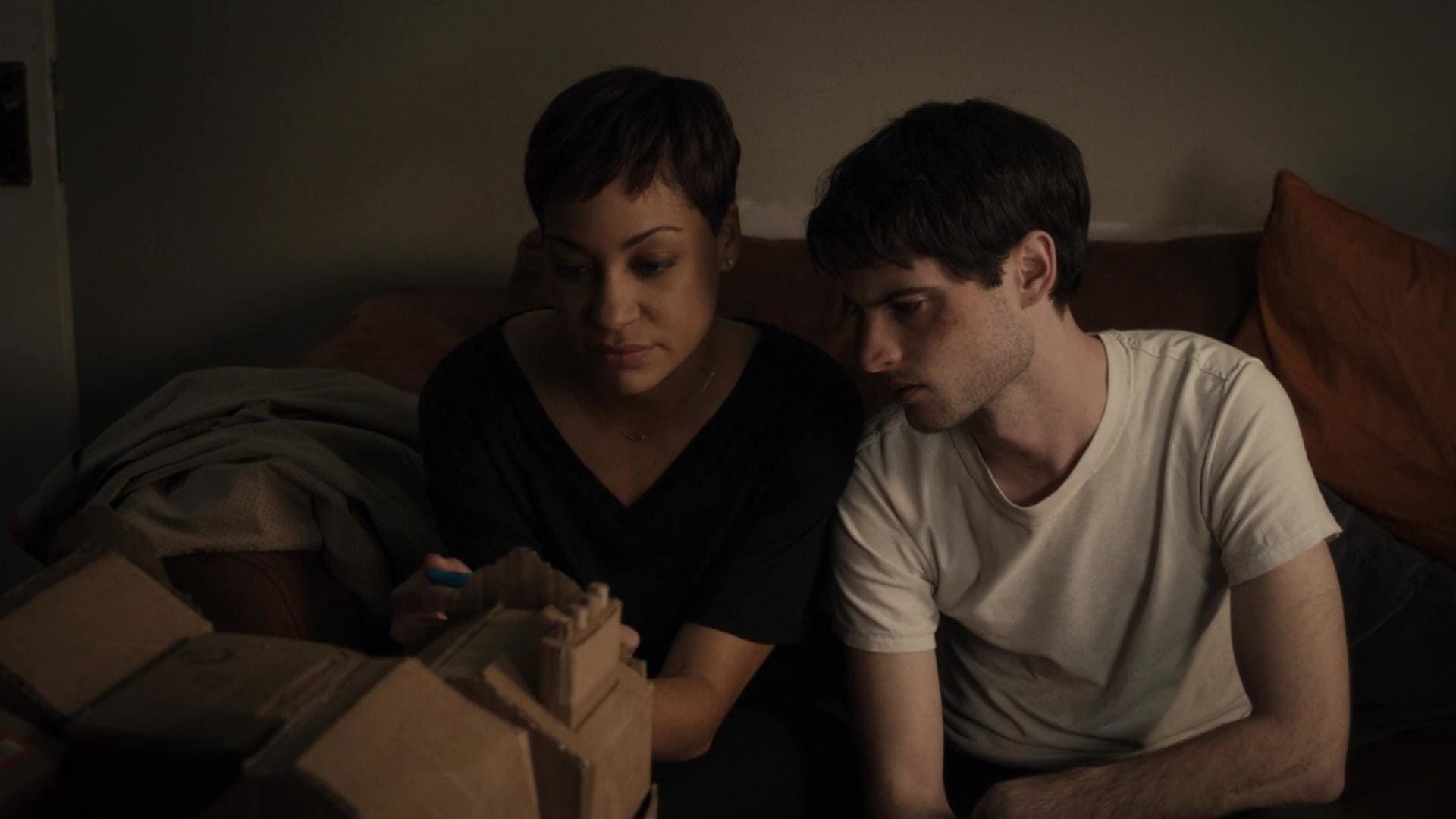OK, first, I have to stop you for a second, and tell you something. This movie, and its original novel, have had collegiate level, yay, even doctoral level, papers written about it. Papers that utilize words and phrases like restorative nostalgia, anti-mimetic polemic, and the like, while deconstructing Proust, Freud, and Nietzsche, while grappling with ideas in the space of transhistorical utopian reconstructions. Yeah. I just typed that. But trust me – it’ll be worth it and will be a blast to discuss, because this movie is a complete, 100% jump ball. It could mean ANYTHING. And it was a blast to watch at the same time. You guys have GOT to watch this movie.
Don’t believe me, here’s a trailer – but do us all a collective favor, and don’t watch it. The trick for you, right now, probably will be finding a place to watch the movie. The only place I am seeing it right now is over at these online streaming locations:
Now, before we start walking through this brain-frack of a movie – I need you to do a little mental calisthenics. Look out the window, take a deep breath…and then exhale. Because this one is going to be crazy. OK?
Remainder Movie Walkthrough
The opening of the movie Remainder is possibly one of the most important movie openings ever. So many seemingly insignificant details are thrown at the viewer right out of the gate. Suitcases, random people walking by, cops walking through…all with enormous relevance to the overarching movie. So yeah, the movie opens with a man, named Tom, walking with a suitcase, and heading across a crosswalk. He looks back, sees an African American woman staring at him, and then heads across the street. And as he’s turning to continue walking, he is slammed by something that knocks him completely out, wipes out his memory, and puts him in the hospital for months and months. And trust me, we will come back to this moment again. But let’s drop a bookmark in this moment for now.
Our protagonist, who has to learn to do everything all over again, has absolutely no memory of anything prior to his accident. But, occasionally, when the moments and the experiences are just right, Tom will have these moments of transcendent memory. Moments of a boy, and a coin, of a woman, of various shards of thoughts and potential past experiences. He doesn’t know what these “memories” are, or even if they are real or not. But these thoughts – ideas – memories – are sort of like crack to our guy. And in particular, he is curious as to who this boy is, and what this coin is all about. But he notices, in those moments, this epiphanic exultation, a sort of euphoria of memory that causes him to do absolutely anything and everything he can to capture these moments and live off of them as much as possible.
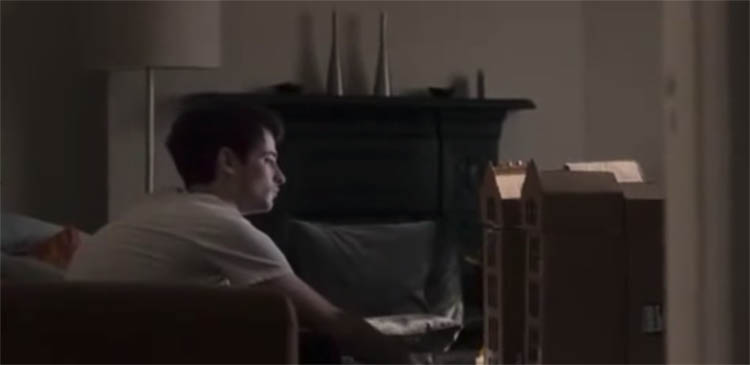
And when Tom settles the lawsuit with the company, whose debris pinned him to the pavement, for close to 10 million dollars, he has everything he needs to begin chasing these memories with all the vim and vigor necessary. At first he finds himself building mock-ups of buildings that keeps reappearing in his head. First sketches, then cardboard models, then more elaborate attempts at reconstructions…but they all ultimately fail. Then one day, he calls a service to help him find the apartment building that recurringly finds a part in his memories. And after buying it, he then begins hiring actors to fill the tenement, doing exactly what he remembers (or doesn’t remember) them doing. There is the old liver lady. The piano player that is constantly playing through Chopin’s oeuvre. The couple on the first floor he can’t remember what they look like, so they wear bags over their heads. Etc, etc.
The Characters of Dubious Origin
And throughout our hero’s effort at reenactment, there are a few individuals that percolate in and out of his life randomly. The two biggest are Greg (who may, or may not be, an old friend of Tom’s) and Catherine, Greg’s apparent ex-wife, (who may or may not be romantically involved in Tom’s life). But, he may actually hate Catherine too – of this we are none too clear. And there are also two individuals, who pose as cops, but most likely, are not, who seem to be hunting down Tom for some reason – but we don’t ever really find out.
All of these characters remind me of the relationships in Memento, when, as we move backward in time, we realize more and more just how horrible these people are moving in and around Leonard. Like Natalie, who comes crying to Leonard, bloody nose, begging for him to help her, but as we move backwards in time we realize she battered herself, right in front of him, just to manipulate him a moment later. Similarly, we have no idea at first what it is exactly that Catherine wants. We know something else is going on, but we really don’t have the whole picture at first, so we just can’t know.
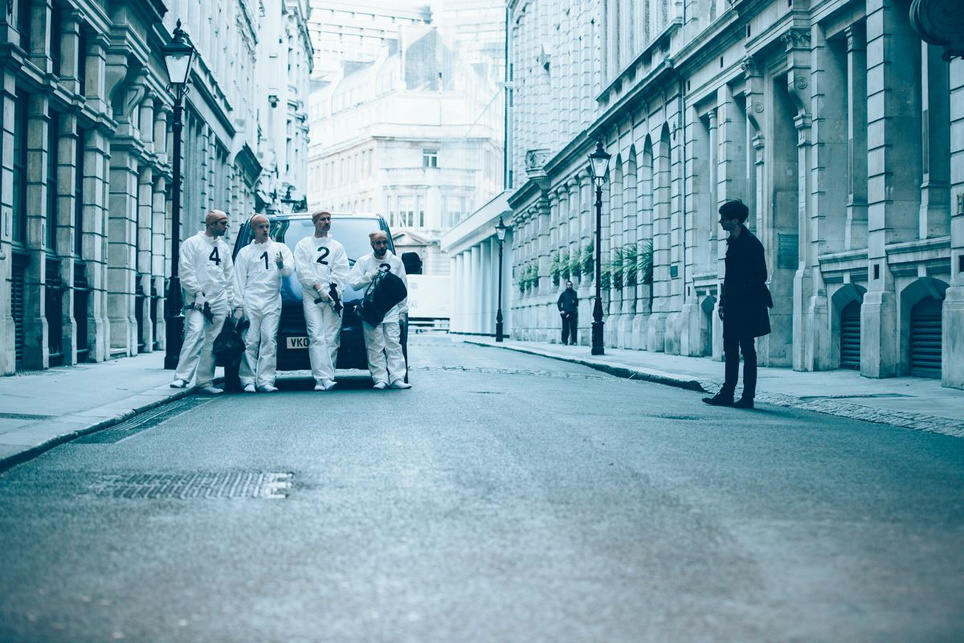
The Mimesis Rabbit Hole
Really though, all the other character circulating around Tom are very unimportant to the central idea of the movie Remainder, which is that of reenactment. Or mimesis. Because it is in these accurate portrayals of a feeling, of an experience, that these transcendent experiences occur. It’s as if Tom is chasing the high of an extremely elusive drug. And that drug has him committing large swaths of his $10 million settlement as he moves from buying apartment buildings, to recreating them in warehouses from top to bottom, as well as the bank next door, and the entire street, including clouds, and the general ambiance of the London area.
A key detail in these reproductions are Tom’s relationships with the various actors playing the parts of the bit-parts of his memories. He rules them with a tyrannical hand. He pauses and stops them for hours on end – standing over the sink, getting tea, vacuuming, carrying in the groceries, playing the piano, mid-chord. (I haven’t spoken much about the book, but after having just read it, he is much much more evilly depicted with how he interacts with these actors.) And while, it never goes over the top, Tom has zero interest in these people, save for recreating a moment, enacting that high, remembering one more detail, seeing just a little bit clearer. Yet, it’s not hard to just sideways step a moment, and to wonder how much of a God Complex Tom has with regards to these people. $10 million is enough to send an average person mad. (Don’t think I’m right – how about this discussion talking about how lottery winners end up with ruined lives more often than not.) And apparently, as we can see quite clearly, if anecdotally, that Tom’s particular madness is control.
Regardless, Tom soon has the epiphanic insight through his other recreative delights, that somehow, he knows for certain, there was a bank heist involved in here somewhere. So an ex-con bank robber is brought on board, and four bank robbers to execute the plan. Hundreds of times they practice, and hundreds of time Tom watches as he pushes them to get under 5 minutes. But in yet another important epiphany, Tom decides that they should run the bank heist for real, and that this would give the highest level of fidelity possible. But! The trick, though is that they won’t tell the robbers that that is what they are going to do. And in another hitch, Naz tells Tom that there are 12 different scenarios in the bank heist, and 104 permutations, but all of them require keeping the information from leaking out. And like that, they realize that they will have to kill the players in the “fake” heist in order to hide what it was that they were trying to accomplish. That it wasn’t about money per se, but rather that it was about Tom’s reenactment addiction.
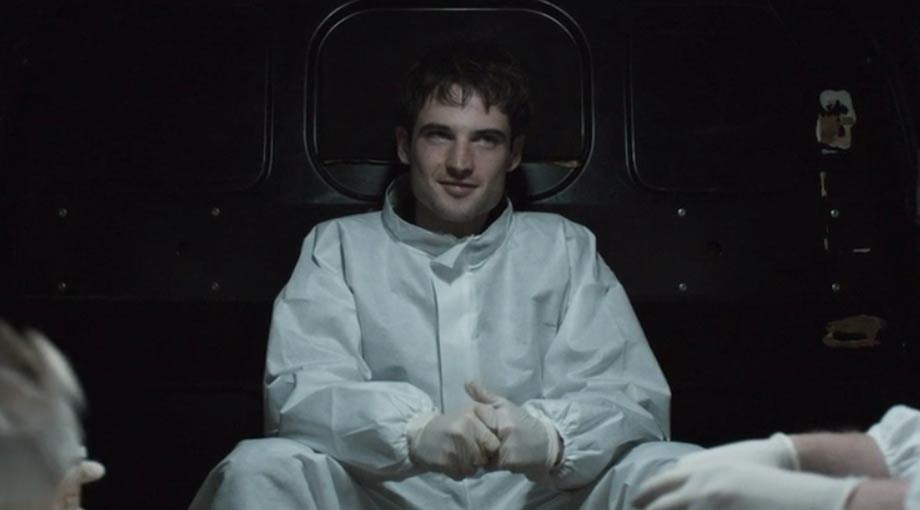
The Remainder Moment of Truth
And so the decision is made that Tom will join the bank robbers, as they think they are doing just one more trial run. Save for the loaded guns, and the added member of the team, it’ll go perfectly, right?
Well, Catherine, is heading into the bank, to pick something up out of one of the vaults. And during the robbery, Tom is convinced that this suitcase is his, regardless of what might be inside. And as the robbers come running out of a fairly successful robbery, one of the robbers trips on the carpet, and is shot by another robber. Everyone on the team is extraordinarily confused as to why the bank robber is covered in blood. And then Tom, one by one, shoots the remaining members of the team, and he heads out onto the street with the suitcase. Where he realizes, that this is the moment where he will be crushed again into the sidewalk by something falling from the sky.
“About the past I can say very little. Something fell down from the sky. Technology, bits, parts, squashing me onto the pavement. And then nothing. A blank. Eventually the sun will set, and the universe will run down like a toy whose spring is unwound, then there will be no more music, no more loops, and there will be nothing to recreate. No buildings to renovate, no people to rehearse, how to freeze, how to move. For now though, the clouds will part and something will fall down, turning, returning, heading back, getting nearer. Here I am. Waiting, reborn, again.”
The Serious Epistemological Search For Understanding
Like the unnamed protagonist in Tom McCarthy’s novel, Remainder, I found myself wandering the wide array of published papers that researched and grappled within this novel and its cinematic counterpart. And, like our unnamed hero, I continued to find myself back at the beginning again, constantly wondering how I got there…reborn, waiting, yet again. Want to join me on my efforts to tilt at this particular windmill? Here I’ll list just a smattering of them that I have found:
‘The Search for Authenticity in Tom McCarthy’s Remainder‘
‘Compulsion to Re-enact: Trauma and Nostalgia in Tom McCarthy’s Remainder‘
Posthumously Speaking: Thanatography in a Posthuman Age
Playing for Real. Reconstructing Authenticity in “Remainder” by Tom McCarthy
Tom McCarthy. Recessional – Or, the Time of the Hammer. Zurich, Berlin: Diaphanes, 2016.
‘The cogs and sprockets of his body…’: Tom McCarthy and Encountering Time
The Spectre of Authenticity in White Noise and Remainder
I literally have read 250 pages of academic papers thinking about this book. At least. So many, that I decided I had to actually read the book myself. Which, in turn, sent me back to the papers and the scholastic debate, then back to the book, then back to the movie, and then the papers again, in order to really digest the various ideas and permutations of insight that could be found within its pages. But all of this literary kerflufflery started with a 9,000 word polemic written by Zadie Smith which basically compared and contrasted of the novel Netherland (and realism), and McCarthy’s Remainder (aka an avant-garde kick in the teeth). And it was this penumbral firework show that shot McCarthy (who previously couldn’t sell a cup of lemonade, let alone his latest novel) to fame, and no one remembers him as anything but famous these days.
But why? How did Zadie Smith latch on to Remainder as the clarion call battle cry of all true literati elites? Well, as Franzen and David Foster Wallace stated in similar debates, complicated doesn’t need to eschew sheer enjoyment. And Remainder is a fantastic read, while also being so incredibly hard to understand that you want to start over again at the beginning straight away. But. BUT! Chief. All I care about – is simply this… WHAT ON EARTH COULD IT POSSIBLY MEAN?
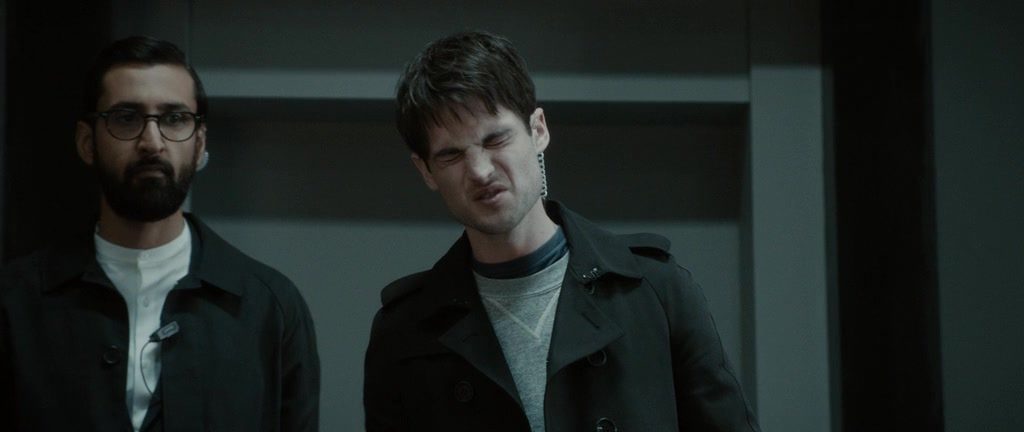
The Theories That Explain Remainder
There are literally so many possibilities and so many varying ways of thinking about this movie that it’s really hard to know where to begin. There are existential theories, and metaphysical ones, there are literal theories, and semi-literal ideas. Psychological Freudian dances. And there are Philosophical insights to be had. And to help us, I’ll try and craft theories from a couple obvious concentrations – but obviously, this is just a Remainder 101 course, and not a doctoral level thesis – which, I’ll leave to Zadie Smith to walk you through.
Nostalgia and Remainder
I have a memory of my childhood – think three maybe – and I’m sitting in a picture window, a pet is nearby, and just buckets – think sheer tonnage – of sunlight is blasting in from the early morning sky. The idea of yearning for the past is where this theory begins and ends.
Nostalgia: a sentimental longing or wistful affection for the past, typically for a period or place with happy personal associations.
When we think about this movie, the place for Nostalgia is a sort of homesickness for what once was. An algia of the mind, driven by a desire to return to what once was. And if we see this movie as a desire for Tom to not only remember his past, but to also return to this sense of normalcy, whatever it might be, it explains his deep desire to recreate these snippets of his past that he is seeing.
Problems with a Nostalgic View – No, no, no – I’m sorry but no. Think about it for a second, Tom never once sees back to before his memory loss. But the boy and the coin man!? Nope, never once. Sure, we catch glimpses of some other thing, but that other thing – as it turns out – is this thing. What? Tom is seeing scenes from his future, which could also be his past. But he isn’t seeing through the veil into his memory. He’s seeing this thing. Whatever this is.
God Complexes and Remainder
The movie plays out the book extraordinarily well. But one of the areas that just fails is Tom’s growingly enormous God Complex. Take, for example, a scene at the mechanics within the book. He is filling windshield washer fluid in the car when he has this epiphanic insight into the world and everything. The fluid seemed to disappear – dematerialize. But when he started up the car, it exploded everywhere, and all over him. So he talks with Naz, and he tells him he wants to reenact this experience, but this time, he wants to set it up so that the windshield wiper fluid completely disappears. Vanishes. I would argue that the ability to dematerialize the corporeal, is totally a god-like ability.
So, one perspective on how to read this film is to see it as man’s desire for control. Control over his success, and control over other humans, sure. But also his desire to have power over the elements. Over the laws of physics. The ability to create ex nihilo, and to return matter to nihilo. This is a megalomaniacal impulse that even the best of us have. Have a rude or unruly boss? You are telling me you wouldn’t use this power to force him into line? Bollocks. Your spouse is just giving you the worst time about something in particular? Of course you hammer that nail down with this power. To hone your world into a bespoke, sanded and varnished intricacy, an example of true perfection, would be the greatest super power of all time.
Problems with a Nostalgic View – not a ton of problems here…save for the fact that there is no need for the repetition if you have this power to bend the world to your will. Why not just force all things into compliance from the outset? Well, because that is impossible for us mortal beings. The reenactment is a cradle of existence, nurtured to the perfection of a pearl in an oyster’s shell.
Freud’s Dance With Remainder
Freud was famous for a number of groundbreaking ideas of the day. I personally can’t stand the guy, but whatever. Anyway, one of the most applicable ideas of his would be that organisms actually don’t solely strive for survival, but rather strive for return to some other preexisting state. He wasn’t certain, but he believed that all organisms must be trying to return to some ancient starting point. That even before the animate object was, there was a sense hearkening back to the inanimate (which can be found in his work, ‘Beyond the Pleasure Principle’). If that is our presupposition for this working theory then we can presume that Tom is chasing this preformed knowledge of the inanimate.
Wait. WHAT? Well, similar to the idea of the Nostalgia theory, we desire to want to return to a better day. But Freud isn’t saying that we want the warm cushy sunlight of our youth, but rather to return to some unknown feeling that even predates our existence. That there is a deeper, bigger picture that we desperately want. If that is the case here, then we are watching Tom do his very best attempt to grasp at this pre-animate feeling or state. This isn’t too foreign a concept, the Christian faith has a similar idea embedded within it, that all humans were made for a bigger, deeper plan, and that we are disconnected and lost absent that connection.
Problems with Freud’s Dance – Nothing, save for the fact that this idea can’t even be proven to exist, let alone proven that this is what Tom is chasing after. But it could very well be that Tom is constantly looping over and over again may dismantle this theory at a more practical level. Why? It makes no sense at all that this looping is occurring, unless it is just to emphasize his failure to achieve this deeper connection?!?
A Sisyphean Judgement View of Remainder
If you have ever been on this site, ever, you’ve probably accidentally collided with one of my reviews that discusses Sisyphus. Why? Because it is an extraordinarily important view of judgment and punishment from a post modern view of the world. In the world of Greek myth, Sisyphus was the king of Corinth and was well known for his pompousness and deceitfulness. And, as a result, ended up paying for his immorality by being forced to roll a boulder up a hill, only to have it roll back down, and for him to roll it up again, for all eternity…
The reason Sisyphus is an enormously important check box to check is because of the obvious looping connection. Can you think of a more appropriate morality tale that involves looping than Sisyphus? Sisyphus was deceitful, caught in his craftiness, and he was forced to pay for it throughout all of eternity. Similarly, what if Tom, in his previous life, was a member of the crew that robbed the bank, and ended up killing every member of his crew in order to get away with the robbery? What if, as he was exiting the bank, he was randomly clobbered by the gods with a piece of space debris? And as Tom headed into the afterlife, he was forced to spend all of eternity trying to figure out who he is, what he did, and what exactly happened. He is there to own his sin, own the deaths he caused, and the injustices he instigated. But he never sees, never acknowledges his wrong and therefore, continues the looping ad infinitum.
Problems with a Sisyphean View – Well, besides the fact that if this was the perfect solution to Tom McCarthy’s Remainder, why isn’t anyone throughout all of academia talking about this connection? And yet, it has got to be at the very least considered. Tom, at the very least, is a very unpleasant person. Worst case, he’s downright evil. Shouldn’t he be judged for his actions? Shouldn’t we all? Barring some sort of intervention, don’t we all innately believe in some idea of justice and balancing of the scales? Otherwise what is this thing called life all about??
Final Thoughts on the Movie Remainder
It’s no wonder I’m not able to get more movies done each week. I literally have no ability to skim and check the box to get something done. I want to know everything about a thing. DeKev mentions a title of a movie, and after reading hundreds of pages of academic papers, and the novel it was based upon, I’m still grappling with this movie. Which, if pages read were some sort of a progress bar indicating quality, this movie would win. Not sure what it would win, but it would win. I watched with an eyebrow cocked and a sick fascination of what was about to come. And just like I feared, it delivered exactly what I was worried it would deliver. A mindjob that still has my head spinning well after it is over.
What did you guys think of it? Do you have a theory to add to the pile? I don’t even think I’ve scratched the surface of the theories possible to explain this movie.
Edited by, CY

